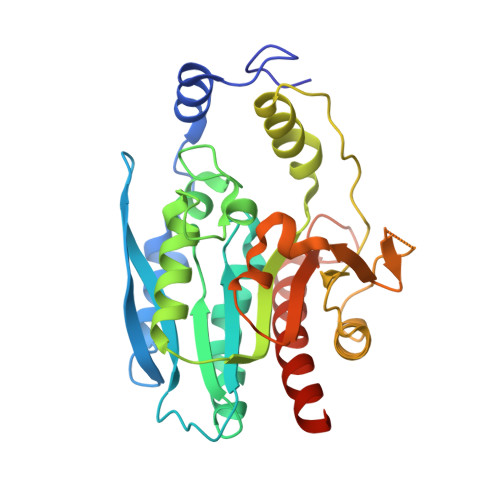Structure and Function of REP34 Implicates Carboxypeptidase Activity in Francisella tularensis Host Cell Invasion.
Feld, G.K., El-Etr, S., Corzett, M.H., Hunter, M.S., Belhocine, K., Monack, D.M., Frank, M., Segelke, B.W., Rasley, A.(2014) J Biological Chem 289: 30668-30679
- PubMed: 25231992
- DOI: https://doi.org/10.1074/jbc.M114.599381
- Primary Citation of Related Structures:
4OKO - PubMed Abstract:
Francisella tularensis is the etiological agent of tularemia, or rabbit fever. Although F. tularensis is a recognized biothreat agent with broad and expanding geographical range, its mechanism of infection and environmental persistence remain poorly understood. Previously, we identified seven F. tularensis proteins that induce a rapid encystment phenotype (REP) in the free-living amoeba, Acanthamoeba castellanii. Encystment is essential to the pathogen's long term intracellular survival in the amoeba. Here, we characterize the cellular and molecular function of REP34, a REP protein with a mass of 34 kDa. A REP34 knock-out strain of F. tularensis has a reduced ability to both induce encystment in A. castellanii and invade human macrophages. We determined the crystal structure of REP34 to 2.05-Å resolution and demonstrate robust carboxypeptidase B-like activity for the enzyme. REP34 is a zinc-containing monomeric protein with close structural homology to the metallocarboxypeptidase family of peptidases. REP34 possesses a novel topology and substrate binding pocket that deviates from the canonical funnelin structure of carboxypeptidases, putatively resulting in a catalytic role for a conserved tyrosine and distinct S1' recognition site. Taken together, these results identify REP34 as an active carboxypeptidase, implicate the enzyme as a potential key F. tularensis effector protein, and may help elucidate a mechanistic understanding of F. tularensis infection of phagocytic cells.
Organizational Affiliation:
Biosciences and Biotechnology and Lawrence Livermore National Laboratory, Livermore, California 94550.























